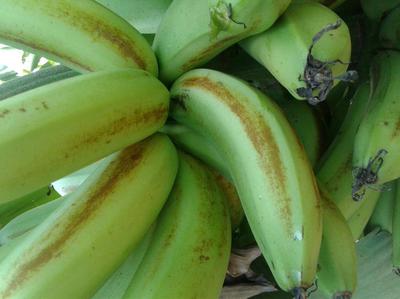Banana Rust Thrips
Chaetanaphothrips signipennis
Insect
In a Nutshell
- Water-soaked areas on fruits.
- Spots turn into rusty, rough spots - deep red to dark brown, covering whole skin.
- Cracks or splits on more mature fruits.
- Adults are slim, yellow to brown, about 1.3 mm in size with narrow fringed wings.
Can also be found in
Symptoms
The infestation can occur at any growth stage and is visible on leaves, pseudostems and fruits. Adults and larvae usually settle behind the bases of leaf sheaths. Nymphs are gregarious and feed by sucking the plant sap with their mouthparts. Initial symptoms appear as water-soaked areas on fruits. Over time, these areas give the fruits a characteristic rusty aspect, with deep red to dark brown colored skin. Usually, only the peel shows damage, but if infestation is heavy the whole fruit can show signs of damage. On more mature fruits, cracks may be visible. Sometimes the fruits split open. The infestation is most harmful to fruit bunches when infested in early development stages.
Recommendations

Organic Control
Parasitic insect species from the chrysopidae family and ladybug beetle species can be used to control the pest. Some ant species might be effective, too. They attack the pupae in the soil. If not sure whether the plant material is from a healthy source, a hot water treatment may help to reduce the infestation risk.

Chemical Control
Always consider an integrated approach with preventive measures together with biological treatments. If insecticides are needed, applications should be located on the soil to kill the pupae, as well as on plants and fruits in order to kill the adults. This approach might be the only possibility to avoid re-infestation.
What caused it?
Symptoms are caused mainly by the thrips Chaetanaphothrips signipennis, but other species may also be involved (Helionothrips kadaliphilus). The pest is most commonly transmitted via infested plant material, or to a lesser degree directly by the insects flying between trees. Adults are slim, yellow to brown, about 1.3 mm in size and have narrow fringed wings with two dark areas on the forewings. The female lays tiny eggs (not visible to the naked eye) on the under leaf sheaths and where fruits touch the plant. After about 7 days, the wingless, white to cream larvae hatch. They grow to the size of adults within about 7 days. Then they move to the ground, enter the soil on the plant base and pupate. After an additional 7-10 days, the new generation of adult thrips hatches. There can be many generations per year. During hot and humid weather there can be population peaks.
Preventive Measures
- Use healthy planting material from certified sources.
- Remove volunteer plants and avoid cultivating host plants around the main crop field.
- Check your plants or fields periodically for any sign of the pest.
- Use bunch covers in early growth stages already to protect the plants.
- Remove infested plants and destroy them by burning.
- Remove abandoned plantation areas as these can serve as sources for pest spreading.



